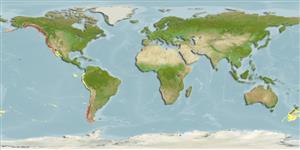Environment: milieu / climate zone / depth range / distribution range
Écologie
marin bathydémersal; profondeur 25 - 800 m (Ref. 6793). Deep-water; 60°N -
Eastern Pacific: Alsek Canyon, southeastern Alaska to Isla Cedros, central Baja California, Mexico.
Taille / Poids / Âge
Maturity: Lm ? range ? - ? cm
Max length : 35.0 cm TL mâle / non sexé; (Ref. 2850)
Description synthétique
Clés d'identification | Morphologie | Morphométrie
Épines dorsales (Total) : 0; Rayons mous dorsaux (Total) : 72 - 78; Épines anales: 0; Rayons mous anaux: 57 - 65; Vertèbres: 42 - 46. Dorsal origin over anterior part of upper eye. Caudal rounded. Pectorals small and narrow.
Occurs in the vicinity of rocky areas (Ref. 4925). Good food fish but is of little commercial importance due to its small size (Ref. 6885).
Vinnikov, K.A., R.C. Thomson and T.A. Munroe, 2018. Revised classification of the righteye flounders (Teleostei: Pleuronectidae) based on multilocus phylogeny with complete taxon sampling. Molecular phylogenetics and evolution, 125:147-162. (Ref. 122998)
Statut dans la liste rouge de l'IUCN (Ref. 130435)
Menace pour l'homme
Harmless
Utilisations par l'homme
Pêcheries: intérêt commercial mineur; pêche sportive: oui
Outils
Articles particuliers
Télécharger en XML
Sources Internet
Estimates based on models
Preferred temperature (Ref.
123201): 4.5 - 9.6, mean 6.2 °C (based on 167 cells).
Phylogenetic diversity index (Ref.
82804): PD
50 = 1.0000 [Uniqueness, from 0.5 = low to 2.0 = high].
Bayesian length-weight: a=0.01148 (0.00524 - 0.02518), b=3.09 (2.89 - 3.29), in cm total length, based on LWR estimates for this (Sub)family-body shape (Ref.
93245).
Niveau trophique (Ref.
69278): 3.5 ±0.3 se; based on diet studies.
Résilience (Ref.
120179): Faible, temps minimum de doublement de population : 4,5 à 14 années (tmax=20; tm=4).
Fishing Vulnerability (Ref.
59153): Low vulnerability (25 of 100).
